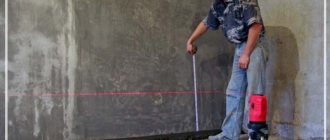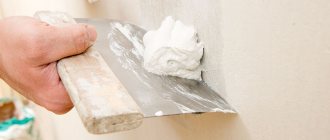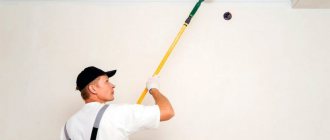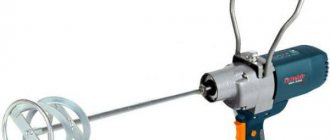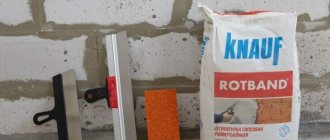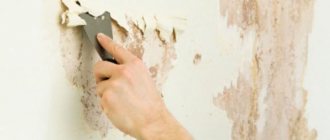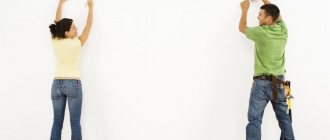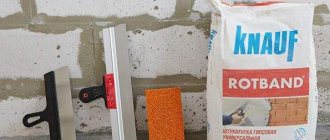Carrying out finishing work in an apartment often includes leveling the walls using plastering. In order to determine in advance the amount of material to be purchased, you need to know the consumption of plaster required for this operation. Such awareness will help not only to avoid downtime caused by a lack of dry mixture, but also to avoid unnecessary costs. Hired workers, wanting to earn extra money, often overestimate the amount of dry mixture consumed, and such a calculation will bring them to clean water.
Important! To calculate the consumption of plaster that will be required to obtain a flat surface, it is not enough to simply multiply the consumption of the dry mixture per 1 m2 indicated on the bag with the plaster mixture by the area of the wall being treated. In the calculation, parameters such as the curvature of the walls and the type of material used for plastering should be taken into account.
Determining layer thickness
To make a preliminary calculation and find out how much material is required per square meter of coating, you need to determine the thickness of the plaster to be applied. To do this, the first thing you need to do is clean the wall surface as thoroughly as possible.
Smooth walls in apartments, especially those built during the Soviet period, are quite rare. To find out the deviation of the wall, you should level several beacons on it. The layer thickness is calculated as follows:
- The deviation from the plane is measured for each beacon.
- All results are summed up and divided by the number of measurements. The resulting value will be the average layer thickness, on which the consumption of plaster required to level the available square meters of wall will depend.
For example, you need to plaster a wall with an area of 12 m2 with a maximum deviation of 6 cm. Four beacons were installed that showed deviations of 1.2, 4 and 5 cm. The average layer thickness in this case is found as the arithmetic mean:
(1+2+4+5)/4=3 cm.
In old apartments, there are often cases when the walls are filled unevenly, and installing beacons will be quite difficult. But otherwise it is not possible to calculate how much material is required for each square meter of surface.
In new buildings, walls rarely deviate from the vertical plane by more than 20–25 mm. In these cases, a thin leveling layer will be required, therefore, the consumption of plaster per 1 m2 will be small.
Note! In any case, the thickness of the layer cannot be less than the thickness of the beacon. The standard beacon profile has a thickness of 6 mm, and this should be taken into account when calculating the required amount of plaster mixture.
Reasons for increasing plaster consumption
Calculation of plaster for walls per 1 sq.m. depends on several factors:
- Uneven walls. According to norms and standards, all surfaces must be on the same level. However, this is almost impossible to do during construction. And in old buildings, the deviation can be even more than 5 cm. To do this, they will have to be leveled, as a result, the consumption will increase. The greater the deviation, the more solution will be needed. A lot of the mixture is also spent on sealing cracks and chips;
- Type of solution. Each type of mixture has a different consumption rate per square meter. Therefore, the calculation is made for each specific situation.
Dependence of mixture consumption on the type of plaster
Having determined the average size of the leveling layer, you can calculate the required amount of material depending on the type of plaster mixture used. The packaging must indicate how much material is required to form a leveling layer of 1 cm on a surface of 1 m2. This value should be multiplied by the average thickness of the plaster obtained earlier and by the number of square meters of surface to be leveled.
USEFUL INFORMATION: Do-it-yourself structural decorative plaster for interior work
Where can I use Rotband?
Nowadays, for plastering walls made of various materials, there are a large number of alternative mixtures, which have a wide range in both price and quality. At the same time, specialized compounds are produced, the use of which is recommended specifically for a specific type of concrete block or type of brick.
All of them are based on two fundamentally different main ingredients - cement and gypsum. Cement plasters are recommended for use in rooms where, during operation, a constantly high level of air humidity and noticeable temperature changes are expected. Most often this means a bathroom in an apartment or a garage or an indoor swimming pool in a private house.
Gypsum mixtures are non-frost-resistant and sensitive to high humidity. Rotband is not suitable for finishing walls for painting, as it shrinks during the drying process. To prepare the ideal surface that walls require for painting, you will need to apply at least one more layer of universal gypsum putty, such as Knauf Fugen, on top of the Rotband layer. Ideally, add a third finishing layer of Vetonit putty, which does not shrink at all.
The time for complete drying of walls plastered with gypsum Rotband ranges from 2 to 7 days, depending on temperature, air humidity and the intensity of ventilation of the room. On a dry summer day, complete drying occurs within two days; it can be determined by the color of the surface, which brightens as moisture evaporates from it.
Before applying plaster, be sure to use special primers to treat the surface of the walls. Without their use, the likelihood that the finishing layer will begin to actively crumble when exposed to a drill increases significantly, when it becomes necessary to hang a shelf or some other heavy structure on the wall. The average primer consumption is approximately 100 grams per 1 m².
Characteristics of various types of plasters and approximate consumption rates
Each type of plaster mixture has its own characteristics, and the material consumption per 1 m2 of surface can vary significantly.
- Gypsum is durable, dries quickly, very easy to use, but in most cases it is not suitable for wet rooms. Approximate consumption – 9 kg per square meter with a thickness of 1 cm.
- Cement is universal, moisture resistant, can be applied to concrete, brick and even old plaster. Suitable for any room, including the bathroom, kitchen and open balcony. The highest consumption is 17 kg/m2.
Working with cement mortar is quite difficult, so many owners prefer to trust specialists who offer services for applying plaster mortar by machine.
Consumption of dry plaster mixture per square meter of wall
When starting renovations in an apartment, it is necessary to accurately determine the amount of materials purchased and the total amount of costs. One of the important items on the list of all works is the alignment of walls, ceilings and facades. By calculating the plaster consumption per 1 m2, you can estimate the costs at this stage.
It seems that only a professional can determine the exact volume of material. But if you take into account all the factors that affect the consumption of plaster, then this procedure will not seem so complicated:
Surface curvature
. Vertical and horizontal deviation is the main indicator. There are different situations: there may be initially smooth walls in “Khrushchev” buildings and significant corners in new buildings.
Type of dry mix used
. Depending on the specific type and brand of product, the consumption of plaster per m2 will vary.
Calculation method
Having understood the main factors, you can move directly to the assessment process. The technique consists of the following points:
Thorough cleaning of walls.
Installation of beacons - special metal profiles with a protrusion of 6 - 10 mm.
Carrying out deviation measurements at control points using a rule.
Calculation of the arithmetic average of the results obtained. Don't forget to write down all local values at each point; this will be needed during the plastering process.
Pay attention to the packaging. All manufacturers write an approximate rate of plaster consumption per square meter, subject to a layer thickness of 1 cm.
How to get the final figure? To do this, it remains to carry out a number of simple calculations. For example, you are going to decorate a room of 15 square meters. m and want to purchase Rotband gypsum plaster from Knauf. The manufacturer indicates a consumption of 8.5 kg/sq. m. Having hung beacons on the walls and calculating the average deviation, it turned out that the final value is 3 cm. We multiply 8.5 * 3, we get 25.5 kg/sq. m is the consumption of plaster per 1 m2. The final volume for the entire room is 25.5 * 15 = 382.5 kg, or 13 Rotband bags.
Despite the certain labor intensity of the process, especially at the stage of installing beacons and measurements, the above method will allow you to independently determine the amount of material to purchase. But even if you invited a construction team, it will be useful to monitor the process.
Average plaster consumption values depending on type
Today you can see a wide range of different types of plasters in stores. In addition, each specific pack contains its own calculation. But what if you plan to do a lot of work at once, which will require completely different mixtures? How then to choose the appropriate option and estimate the costs? For this, there are average figures that will allow you to approximately imagine the amount of plaster required depending on its type.
This is the most common option for leveling walls and ceilings in residential areas. The material has soundproofing properties and retains heat. Since gypsum easily absorbs moisture, it is not suitable for outdoor use. The consumption of gypsum plaster per 1 m2 is 9-10 kg with a layer thickness of 1 cm.
Can be used indoors and outdoors. Cement-lime mortars are very plastic and harden quickly. The dry mixture based on this material is resistant to humidity and temperature changes. The average consumption of cement plaster is the highest among all types - 16-17 kg/sq. m.
- Decorative
Knauf Rotband
“Rotband” is a popular, affordable and high-quality gypsum mixture, optimal for application by hand. The thickness of the layer should not exceed 5 cm. The amount required to treat 1 m2 with a layer of 1 cm is 8.5 kg.
Buy Knauf Rotband in the online store
Anton Tsugunov , I have been doing repairs and finishing since 2003.
I prefer to buy plaster in an online store - it is very simple, convenient and safe. You can buy plaster without leaving your home. Most often I order delivery directly to the site, so as not to waste time and not “damage” the car.
In the online store you can find the exact specifications and real customer reviews.
Moreover, when I pay for the tiles with my card , I receive cashback of up to 30% of the purchase amount!
It turns out to be a double benefit! I don’t risk my health, I don’t waste time on the road, I receive the paid tiles at the time I specified and also save up to 30%.
Plaster is packaged in 30, 10 and 5 kg
How to reduce consumption?
If the layer thickness is planned to be more than 1 cm, but you want to finish the wall with Rotband, then you can simply do a two-layer finish. Apply the first layer of plaster from a cement-sand mixture, and after it has completely dried (at least 30 days), cover the surface with a thin layer of gypsum plaster. This combination will make the surface of the walls strong and durable; in the future, any even heavy structures can be safely attached to dowels and not be afraid that the finishing layer will begin to crumble and crumble.
As an alternative to the classic solution of water and gypsum plaster, sand can be added in such an amount that its weight is comparable to Rotband as 1 to 1. Accordingly, the amount of water here will need to be doubled and the resulting ratio of ingredients will be 10 kg of Rotband, 10 kg sand and 12 liters of water.
A feature of such a solution will be the need to put more effort when working with the composition. The application process will be difficult to a significant extent, since obtaining a good, even surface, similar in quality to the surface where Rotband undiluted with sand is used, will require much more time and effort.
Volma Layer
“Volma” is another plaster widely known in finishing circles, high-quality and inexpensive. A cement-based composition is used for rough leveling; material consumption reaches 12 kg/m2. Volma gypsum plaster mixture is used for treating walls and ceilings for painting or wallpapering and does not require subsequent puttying. Consumption – 8–9 kg/m2.
USEFUL INFORMATION: Is it necessary to prime the walls after puttying before wallpapering?
Gypsum plaster “VOLMA-Sloy” is intended for finishing finishing work manually indoors. It perfectly fills potholes and helps smooth out uneven walls, as it can be applied in a layer of 5 to 60 millimeters. After drying, the composition forms an even layer of white color on the surface, which does not require subsequent puttying. This mixture is compatible with a wide range of building materials. You can buy it for application to brick, concrete, aerated concrete, etc.
Advantages:
- Versatility.
- Resistant to cracking.
- Affordable price.
- Easy to apply.
Technical features of the mixture
The composition of gypsum plaster has the following characteristics:
- the layer of applied solution can be from 5 to 50 mm;
- the consumption of gypsum plaster is about 8 kg per 1 square meter;
- material fraction size ≈1.2 mm;
- with 100 kg of dry matter, the yield rate of the finished solution is 120 l;
- the density of the material is 950 kg per cubic meter;
- life cycle of the finished mass – 20-25 minutes;
- The drying process takes about 7 days;
- the material is available in packaging from 5 to 30 kg.
Rotband for wall decoration
Construction plaster Knauf Rotband
Comparative characteristics of the plasters Starateli, Teplon, Volma and Vetonit
| Index | Name | ||||
| Prospectors | Teplon | Volma | Vetonit | Rotband | |
| Plaster consumption | 10kg/m2 | 4 kg/m2 | 8-9 kg/m2 | 1.2-1.4 kg/m2 | 8-8.5 kg/m2 |
| Drying time | 7 days | 5-7 days | 4-8 days | 24 hours | 7 days |
| Layer thickness | 5-50mm | 5-30mm | up to 60 mm | 30-50mm | 5-50mm |
| Price category | 8.5$/30kg | 9$/30kg | 8-9$/30kg | 12.5$/30kg | from 5$/30kg |
Rotband
Teplon plaster is a fairly expensive material, but its price is justified due to its long life cycle and thermal insulation characteristics. You can also see Gray Teplon on the market, which will cost much less than its analogues - about $5/30kg.
Volma gypsum plaster is a popular domestically produced material. Volma dry mixtures contain mineral and chemical elements, as well as light binders. They provide Volma with optimal drying time, ease of application and a wonderful finish. After the gypsum coating, Volma fits onto the walls more easily than Rotband.
The Vetonit company presents dry mixtures on the construction market, including moisture-resistant and lightweight cement-based mixtures. Vetonit mixtures are used for both external and external wall decoration, as well as for Venetian plaster. As can be seen from the table, Vetonit, although the most expensive, is a quick-drying material, on which you can also save money due to its low consumption per 1 m2.
Gypsum plaster Knauf Iceberg
Knauf Eisberg gypsum plaster is used for leveling walls and ceilings in dry rooms, repair and restoration work. The material is universal and does not require subsequent puttying. The main component of the building mixture is high-quality gypsum, which is an environmentally friendly and lightweight material.
Consumption: 8.5 kg
Gypsum plaster cannot be used in conditions of high humidity, otherwise it is universal and can be used for different substrates:
- concrete of different structures (dense and cellular);
- cement plaster;
- stone and brick;
- expanded polystyrene and DSP.
Advantages of gypsum plaster
The material “breathes”, regulates the amount of moisture in the air, absorbing it when there is excess and releasing it when there is a deficiency. Creates a favorable indoor microclimate.
The mixture is plastic and easy to apply; it is easier to work with than other types of plaster. The coating provides good heat and sound insulation. The consumption of gypsum mixture is significantly lower compared to cement.
Packaged 30 kg
Calculation of Rotband plaster - calculator
Currently, gypsum plaster "Rotband" (Knauf) is one of the most popular mixtures, which is used to level the surface of walls and ceilings during interior decoration of various rooms. The calculator helps answer the question of how much Rotband is required per 1 m2, as well as for a given area of plastering work, taking into account the thickness of the layer. The uniqueness of our calculator lies in the fact that in addition to information about the quantity of the mixture, the calculation results contain up-to-date information about its cost in leading retail chains.
The area of plastering work is indicated in square meters. m; layer thickness - in cm.
If you do not know the thickness of the plaster layer, enter 2 cm. This is the average value.
How to calculate Rotband consumption
According to the technical documentation, the mixture consumption rate corresponds to 8.5 kg for 1 sq. m. m with a layer thickness of 10 mm. On average, the thickness of the plaster layer is 10–15 mm. We also factor in a required margin of 10% of the benchmark, rounded up.
There is another way to calculate the amount of plaster, or rather, to determine the average layer thickness taking into account angular deviations. To do this, measure the surface on which the plaster composition will be applied in three places. The values obtained during weighing must be summed and divided by three (according to the number of measurements). Example: after measuring, we found that the deviation of the wall/partition surface from the vertical line is 0.8, 1 and 2.4 cm in three different places. Thus, we sum these three values, divide the result by three and find out that the average the thickness of the plaster layer is 1.4 cm - (0.8+1+2.4)/3=1.4. The data obtained can be used to calculate Rotband and its consumption during repairs.
When drawing up a budget for repair and finishing work, you should also take into account the costs associated with transporting materials, loading them and lifting them to the floor. The cost of such services may vary (depending on the location of the premises in which the repairs are being carried out, travel conditions for heavy vehicles, the presence/absence of an elevator, the mode of unloading and loading operations).
If you do not know the area of the walls, then its approximate value can be obtained by having the floor area of the room at hand. In a typical apartment (typical in terms of the number of partitions, window/door openings, and ceiling heights), the wall area can be obtained as follows: The higher the ceilings and the more partitions in the apartment, the greater the specified ratio (for example, 1:3, 4).
When determining the cost of materials for plastering work, it is necessary to take into account the cost of primers (including high-adhesive ones, for example, Beto-contact), plastering beacons, and consumables. An approximate estimate of such costs can be obtained using our repair materials calculator.
Gypsum plaster Unis Teplon
White gypsum plaster "UNIS Teplon" is suitable for interior decoration of walls and ceilings. After drying, it forms a smooth, glossy surface and does not require the application of putty. The perlite included in the mixture makes it light and increases the heat-shielding characteristics.
Material Features:
- Suitable for sealing seams and cracks up to 7 cm in depth.
- The layer when applied without a mesh on the wall is up to 5 cm.
- The layer when finishing the ceiling is up to 3 centimeters.
- The solution must be used within 50 minutes.
- Consumption when applying a layer of 1 cm is up to 10 kilograms per square meter.
USEFUL INFORMATION: Types of mesh for grouting putty and features of their use
Advantages of gypsum plaster "UNIS Teplon":
- Easy.
- Sets within 3 hours.
- Breathing.
- Does not require application of an additional finishing layer.
- Resistant to cracks.
Packaging 30 kg
Main types and composition of gypsum plasters
A feature of gypsum plasters is their limited use: they can only be used for interior work. This factor is explained by its natural ability to absorb moisture.
The following surfaces can serve as the basis for gypsum plaster:
- clay walls and ceilings;
- brick-lined surfaces;
- concrete surfaces;
- walls of any size, finished with cement-based plaster;
- renovation of old plaster surface;
- walls made of various types of concrete with a porous surface: foam concrete, aerated concrete or expanded clay concrete.
Gypsum plasters, which contain polymer components, have a shorter drying and hardening period, which significantly reduces the time for repair work.
Volma
Currently, various additives are introduced into finishing mixtures, which give them new properties. To obtain finishing mixtures of a certain type, hemihydrous calcium sulfate, obtained after grinding and firing, is used as a basis.
The most commonly used components are:
- a group of thermal insulating fillers, such as perlite, foam glass, bulk insulation vermiculite, expanded polystyrene (an effective thermal insulator);
- plasticizers that increase the strength of the solution, reduce the setting speed, which ensures its good shrinkage and increases waterproofing properties;
- additives in the form of zinc or titanium white, providing a light tone to the finishing material;
- special additives designed to regulate the setting time of the solution and the time of its complete hardening.
Final calculation of the required amount of material
Using the data on the packaging, it is easy to calculate the amount of dry mixture that needs to be purchased.
So, for our example with a wall with an area of 12 m2 and a calculated average layer thickness of 3 cm, when using gypsum plaster we get:
3 x 9 x 12 = 324 (kg)
- If the dry mix is supplied in 30 kg bags, you will need to purchase 11 bags.
- For packaging 25 kg - 13 bags.
- For material in 50 kg bags - 7 pieces.
- You will need to buy 33 small 10-kilogram packages.
It is better to buy consumables with a small supply, so that you do not have to make an emergency trip to the store if just a little of the plaster mixture is not enough. And the material from the required manufacturer may simply not be available. It is better to buy an extra bag; the excess can always be used elsewhere.
Thus, having correctly made all the calculations, you can decide on the required budget for repair work, the amount of material purchased and not spend extra money.
How to properly dilute dry putty “Rotband”?
In what proportions should dry gypsum finishing putty “Rotband” be diluted?
How many m2 at maximum consumption will one bag (25 kg) of this putty be enough for? In general, there is nothing super difficult in this work.
Almost all information, including consumption and permissible thickness of the finishing putty layer, is indicated on the container.
There is also the recommended amount of water per kilogram of dry mixture.
For one kg of “Rotband” you will need about 0.65 liters of water, even simpler, for 10 kg 6.5 liters of water.
Knowing these numbers, you can use any amount of putty.
It is better to avoid kneading with a trowel; the quality of such kneading is not high, and lumps may appear in the Rotband.
We will stir (stir), or use a drill with a whisk,
“Rotband-finish” is diluted with clean drinking water, that is, open the tap, this water is suitable.
Next, it is convenient to mix “Rotband” in a construction basin; in principle, a bucket with a bottom without narrowing will also work.
We poured water (leave a little, add the rest later).
Next, we fill in the “Rotband” (if you are doing this work for the first time, you may need a scale to know exactly how many kg you filled in).
They fell asleep, spreading it evenly over the surface, you can wait a little for the Rotbangd to begin to collect moisture.
Next, knead, stir until we achieve a homogeneous mass without lumps, gradually add the remainder of the water that is available.
A couple of minutes of kneading is usually enough time.
Next, we left the Rotband alone for a couple of minutes, stirred again and we were ready to work.
Consumption of finishing putty in kilograms with a thickness of mm per square.
It is correct to dilute dry putty from Rotband in water at a temperature of plus five to plus thirty degrees. When preparing the mixture, it will remain suitable for work longer, the colder the water is (within the limits of the above temperatures)
When diluting Rotband putty, it is better to stock up on scales for accurate dosing of the dry composition and water.
First, pour water into the container in the required volumes (about the volumes for your area of 2 square meters below) and then pour the putty into the water, with constant stirring.
The amount of water, as well as the amount of putty, must be measured in advance so as not to add water to the finished solution. Adding dry putty to the prepared solution so that the latter becomes thicker is absolutely not allowed!
And so, we pour water into one third of our container. We measure out liter jars and pour an equal amount.
For each liter of water we measure 1600 grams of Rotband putty. So if we poured three liters of water, we will immediately measure out the required amount of putty 3 x 1600 grams = 4800 grams and pour it into a separate container so that we can pour it all out during kneading without stopping the mixer.
The duration of mixing is usually 2-3 minutes from the beginning of pouring the mixture into the water until a homogeneous mass is formed. After this, let the solution sit for 5 minutes, mix again and begin application, there is no need to hesitate here. If you are not confident in your experience, do not immediately dilute gypsum solutions in large quantities.
